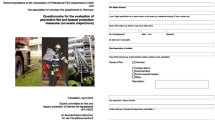Abstract
The National Institute for Occupational Safety and Health (NIOSH) Division of Surveillance, Hazard Evaluations and Field Studies (DSHEFS) conducts investigations of health hazards in the workplace under the NIOSH Health Hazard Evaluation (HHE) program. In September 1990, the International Association of Fire Fighters (IAFF) requested that NIOSH assess the health and safety practices used by fire personnel during a brush fire on September 6, 1990, in Sedgwick County, Kansas. A 25-year-old fire fighter died of heat stroke at the scene.
The NIOSH site visit to Sedgwick County, Kansas included a tour of the fire scene, personal interviews with 25 fire fighters and support personnel, and a review of incident reports, incident command procedures and other documents. NIOSH investigators concluded that a preventable series of events preceded the fire fighter's death. Recommendations were made for incident command and safety procedures, as well as medical monitoring, rehabilitation of fire fighters at fire scenes, and rehydration schedules.
Similar content being viewed by others
References
NFPA.Recommendations for Developing Fire Protection Services for the Public. National Fire Protection Association, Quincy, MA (1989), [NFPA 1201-1989].
NFA.The Incident Command System. National Fire Administration, Emmitsburg, MD (1989), [NFA-ICS-SM].
NFPA.Standard on Fire Department Incident Management System. National Fire Protection Association: Quincy, MA (1990), [NFPA 1561-1990].
NFPA.Standard on Fire Department Occupational Safety and Health. National Fire Protection Association: Quincy, MA (1987), [NFPA 1500-1987].
Brunacini, A.V.Fire Command. National Fire Protection Association: Quincy, MA (1987).
The Oklahoma State University.Incident Command System. The Oklahoma State University, Stillwater, OK (1983).
Grant, H. and Murray, R.Emergency Care. Brady: Bowie, MD (1989).
NFPA.Standard on Medical Technicians Professional Qualifications. National Fire Protection Association: Quincy, MA (1985), [NFPA 1004-1985].
NFPA.Standard on Personal Alert Safety Systems. National Fire Protection Association: Quincy, MA (1988), [NFPA 1982-1988].
Brotherhood, J.R. et al. “Fire Fighters Exposure to Carbon Monoxide During Australian Brushfires”.American Industrial Hygiene Association Journal, Vol. 51, No. 4, (April 1990), pp. 234–240.
Cote, A. and Bugbee, P.Principles of Fire Protection. National Fire Protection Association: Quincy, MA (1988).
Coleman, R.J., Granito, J.A.Managing Fire Services. 2nd edition. International City Management Association. Washington, D.C. (1988).
NIOSH.Criteria for a Recommended Standard: Occupational Exposure to Hot Environments. Cincinnati, OH (1986). U.S. Department of Health and Human Services. Public Health Service, Centers for Disease Control, National Institute for Occupational Safety and Health, DHHS (NIOSH) Publication No. 86-113.
Appendix References
International Standards Organization (ISO).Hot Environments-Estimation of the Heat Stress on Working Man, Based on the WBGT-Index (Wet Bulb Globe Temperature). ISO 7243 (1989).
ACGIH. “Threshold Limit Values and Biological Exposure Indices for 1990–1991”. American Conference of Governmental Industrial Hygienists. Cincinnati, OH (1991), pp. 74–80.
NIOSH.Criteria for a Recommended Standard: Occupational Exposure to Hot Environments. Cincinnati, OH (1986). U.S. Department of Health and Human Services. Public Health Service, Centers for Disease Control, National Institute for Occupational Safety and Health, DHHS (NIOSH) Publication No. 86-113.
Goldman, R.F. Heat “Stress in Fire Fighting: The Relationship Between Work, Clothing, and Environment”.Fire Engineering, (May 1990), pp. 47–52.
Utech, H.P. “High Temperature vs. Fire Equipment”.International Fire Chief, Vol. 39 (1973), pp. 26–27.
Putnam, T. U.S. Forest Service, Northern Forest Fire Laboratory, Missoula, MT. Private conversation.
Author information
Authors and Affiliations
Rights and permissions
About this article
Cite this article
Shults, R.A., Noonan, G.P., Turner, N.L. et al. Investigation of a heat stress-related death of a fire fighter. Fire Technol 28, 317–331 (1992). https://doi.org/10.1007/BF01873400
Issue Date:
DOI: https://doi.org/10.1007/BF01873400



